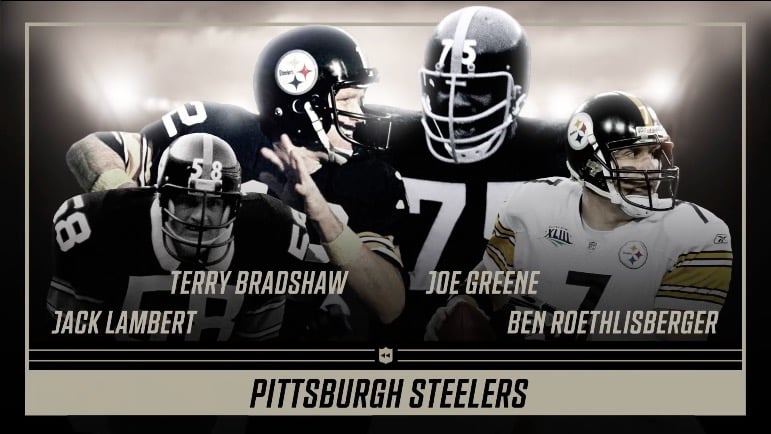When it comes to the Mt. Rushmore of all-time greats in franchise history, narrowing it down to just four players in the illustrious history of the Pittsburgh Steelers is rather difficult to do.
NFL Throwback, part of NFL+, attempted to do just that.
On Mt. Rushmore in Steelers’ history, NFL Throwback selected quarterbacks Terry Bradshaw and Ben Roethlisberger, defensive lineman Joe Greene and linebacker Jack Lambert as the four best players in franchise history.
Honorable mentions included safety Troy Polamalu, cornerbacks Mel Blount and Rod Woodson, linebacker Jack Ham, defensive lineman Ernie Stautner, running backs Jerome Bettis and Franco Harris, and wide receivers Lynn Swann and John Stallworth.
The four that NFL Throwback ultimately settled on is arguably the correct four.
Greene, of course, changed the fortunes of the franchise. Drafted at No. 1 overall in the 1969 NFL Draft by head coach Chuck Noll, Greene became the foundational piece for the Steelers moving forward, setting them up for the dynastic run in the 1970s that saw them win four Super Bowls.
Greene was the focal point, the heartbeat, the key cog in the engine of the Steelers’ famous Steel Curtain defense. Once he came to Pittsburgh, he changed everything. He is Mr. Steeler, and certainly deserves his standing as one of the greatest defensive players in NFL history.
He was easily one of the most impactful, disruptive defenders in the NFL during his time with the Steelers from 1969-81. In 181 career games (172 starts), Greene recorded 77.5 sacks, adding another 16 fumble recoveries and an interception, helping turn the tide within the Steelers franchise, going from doormats in 1969 and 1970 into a bona fide dynasty in the 70s, winning four Super Bowls.
Individually during that span, Greene was a 10-time Pro Bowler, five-time first-team All-Pro, three-time second-team All-Pro, twice won the Associated Press’ Defensive Player of the Year award and was named to the NFL’s All-Decades team of the 70s as well as the 75th and 100th-anniversary teams in NFL history. He went on to have his No. 75 retired by the franchise while heading into the Pro Football Hall of Fame as a first-ballot player.
While Greene was the foundational piece, Bradshaw changed the outlook for the Steelers as they finally had a franchise quarterback, one who they could ultimately build around, even if there were bumps and cracks in the road.
In Bradshaw’s first four seasons after being the No. 1 overall pick out of Louisiana Tech in 1970, he struggled mightily. He threw just 41 touchdown passes in those first four seasons, compared to 73 interceptions, and was constantly scrutinized by the fanbase and his coach.
However, he was exceptionally talented with a howitzer for an arm, and once the talent around him improved offensively, so too did Bradshaw. From 1974 on, after the Steelers had added the likes of Swann, Stallworth and Harris, Bradshaw’s career turned around as he won four Super Bowls, two Super Bowl MVP’s and the 1978 league MVP.
Bradshaw finished his career with 27,989 passing yards, 212 touchdowns, 210 interceptions and went 107-51 as a starter in the regular season and 14-5 in the playoffs, winning those four Super Bowls.
Lambert was another key part of the 70s dynasty, coming to Pittsburgh in 1974 as part of the greatest draft class of all-time. Selected in the second round out of Kent State, Lambert was one of the toughest players to ever play the game and really had a fearsome demeanor on the field that worried opponents.
During his time with the Steelers, Lambert was a nine-time Pro Bowler and six-time All-Pro. He could do it all at the inside linebacker position. He brought an edge to the Steelers’ defense, too, which the unit thrived off of.
Lambert was named the NFL’s Defensive Rookie of the Year in 1974, won the Defensive Player of the Year in 1976, was part of the NFL’s all-decade teams in the 70s and 80s, as well as the NFL’s 75th and 100th Anniversary teams.
In his career, Lambert recorded 28 interceptions, including 6 picks in 1979 and 1981. An iconic player through and through.
Then, there’s Roethlisberger.
Drafted No. 11 overall in the 2004 NFL Draft, Roethlisberger burst onto the scene for the Steelers in his rookie season, taking over for the injured Tommy Maddox in Week 2 against the Baltimore Ravens, eventually going on to win 13 straight games and lead the Steelers to the AFC Championship Game as a rookie.
In Year 2, he helped Pittsburgh win the Super Bowl over Seattle in Super Bowl XL, and then later won Super Bowl XLIII over the Arizona Cardinals on an iconic throw to Santonio Holmes in the back right corner of the end zone. Roethlisberger led the Steelers to an appearance in Super Bowl XLVI against the Green Bay Packers, but the Steelers came up short.
During his playing career, Roethlisberger never quite received the individual accolades he deserved, playing in an era with the likes of Tom Brady and Peyton Manning. But he did earn six trips to the Pro Bowl, led the NFL in passing two times and was the NFL’s Offensive Rookie of the Year.
He’ll be a first-ballot Hall of Famer in 2027 in his first year of eligibility, too.
Across 18 seasons, Roethlisberger threw for 64,088 yards, 418 touchdowns and 211 interceptions, setting every major passing record in franchise history in the process. As the quarterback, Roethlisberger led the Steelers to a 165-81-1 record during his 18 seasons, adding another 13-10 record in the playoffs.








